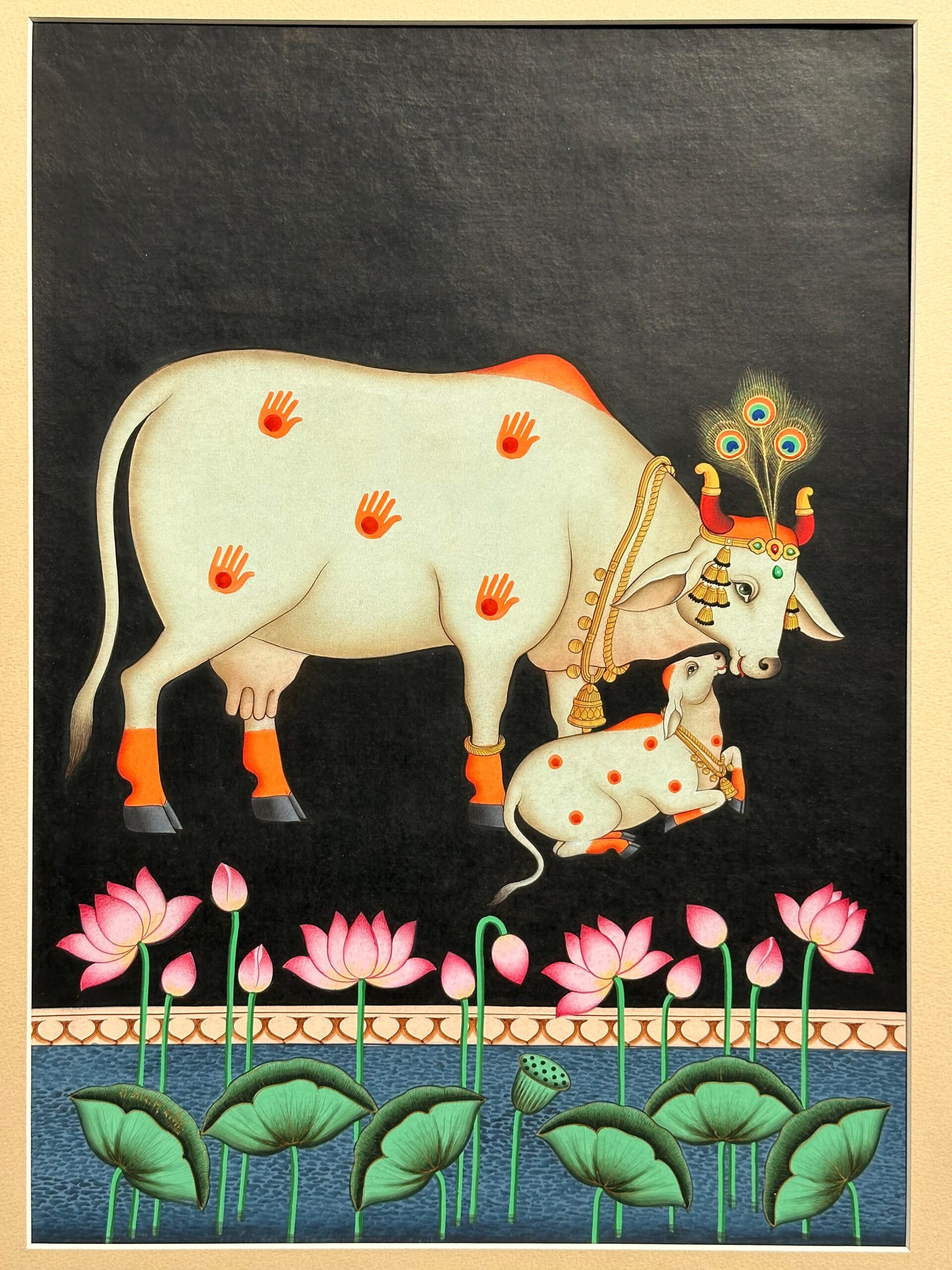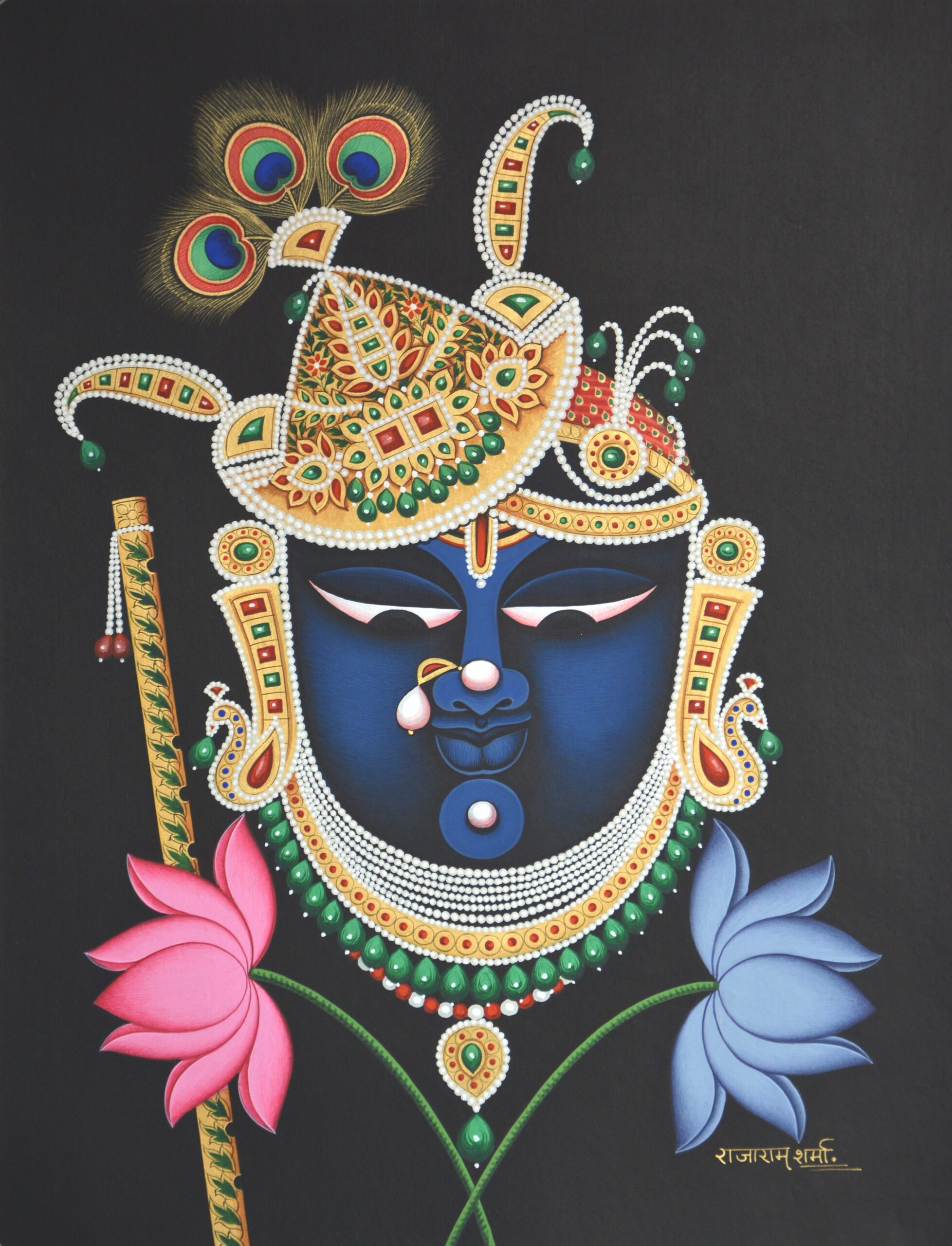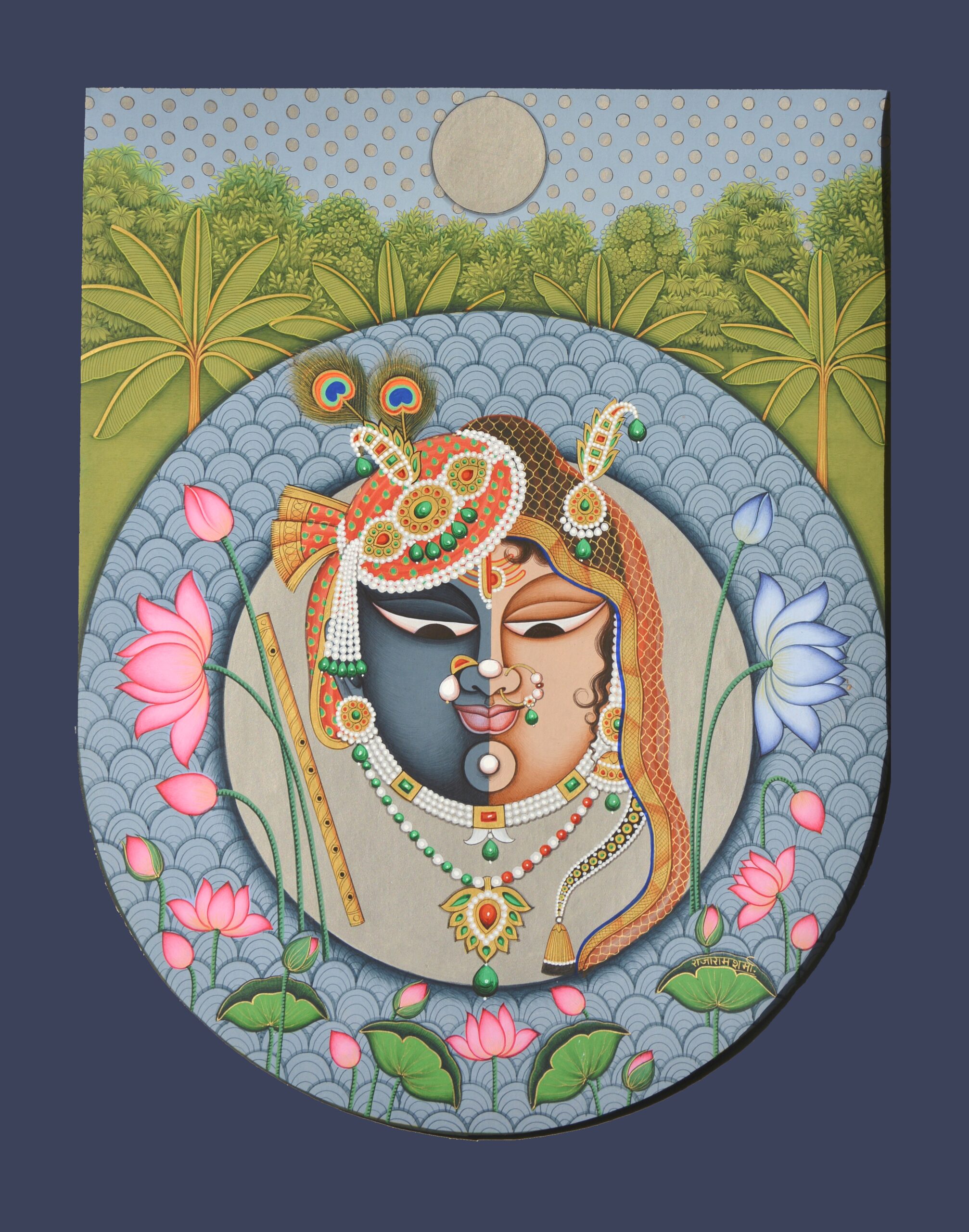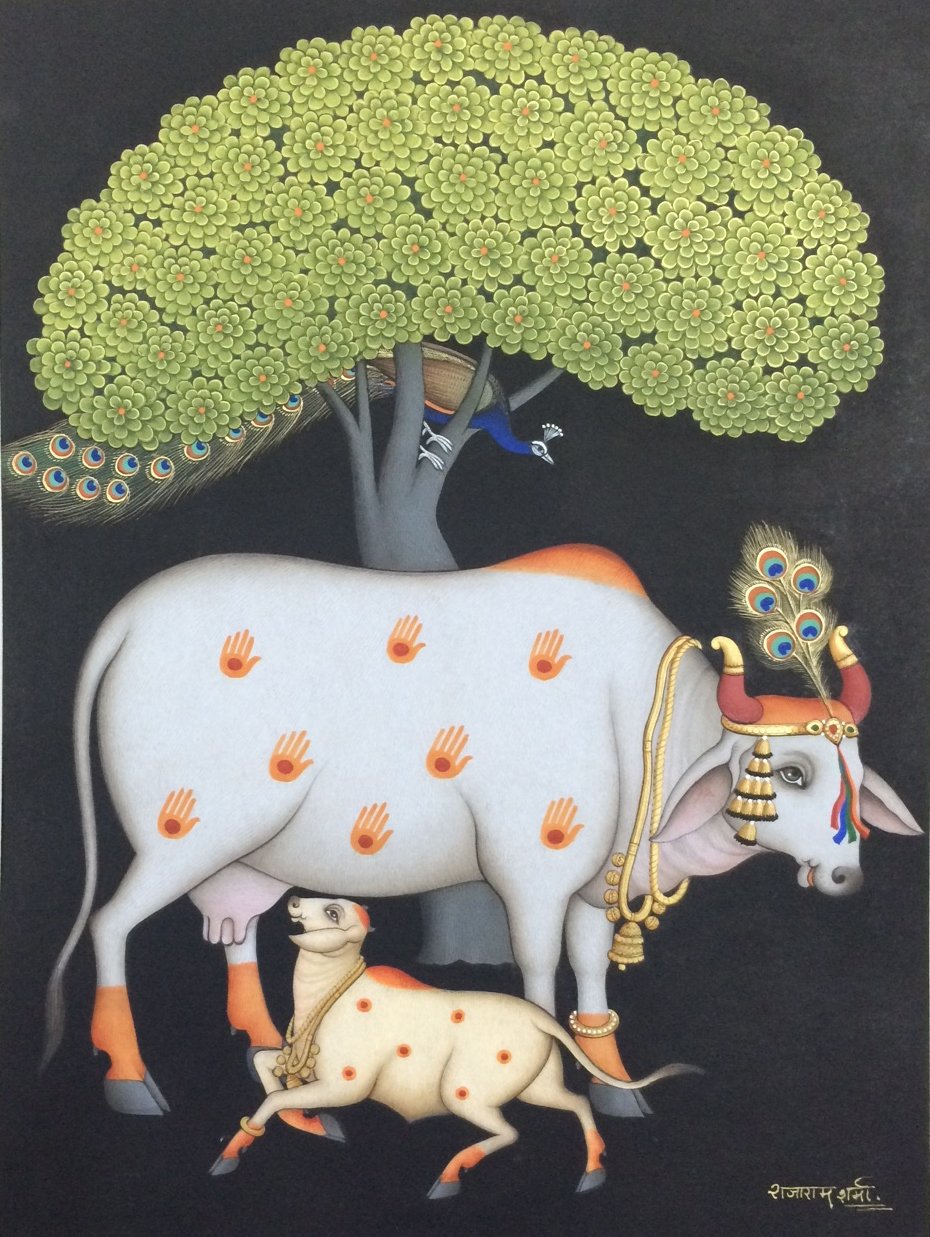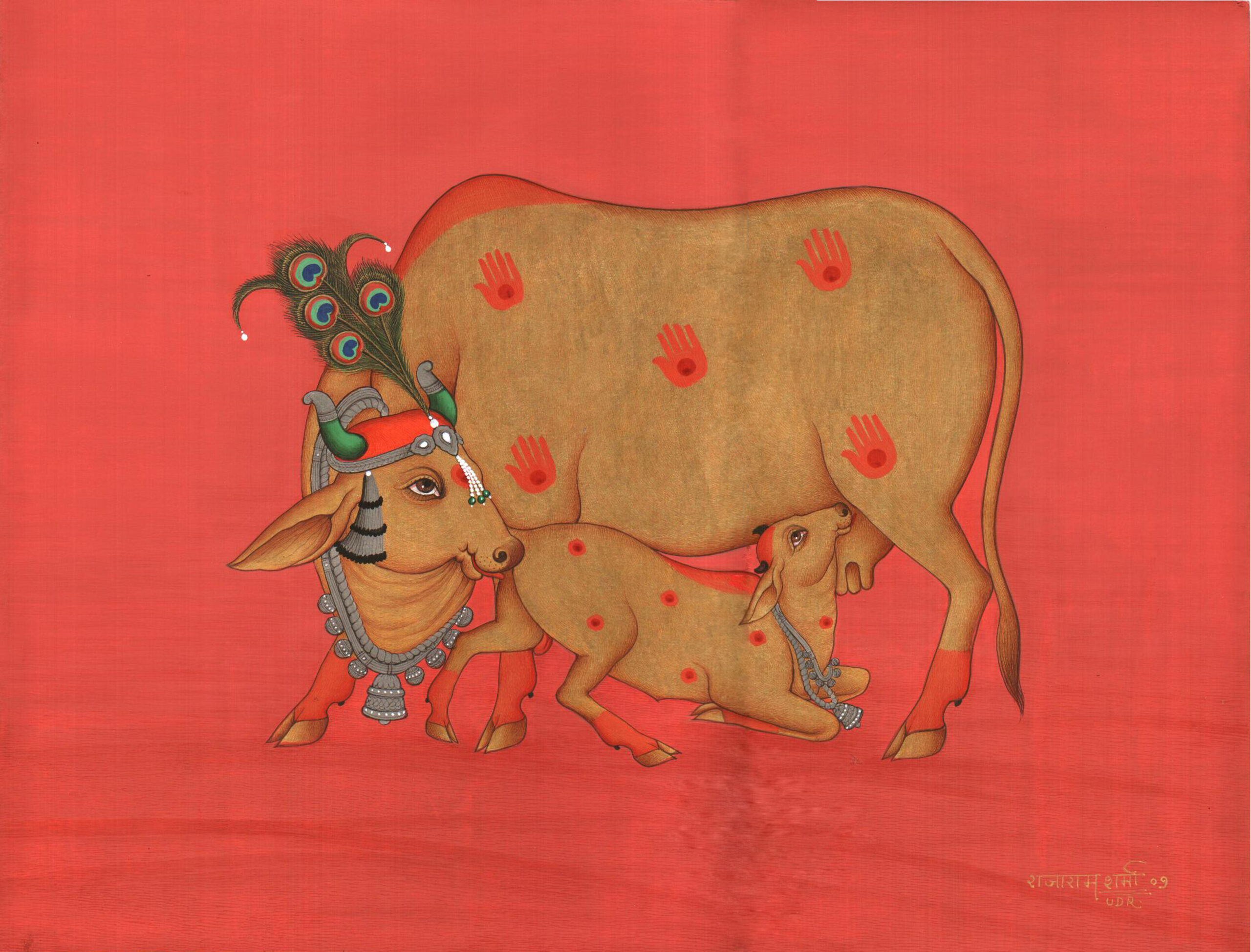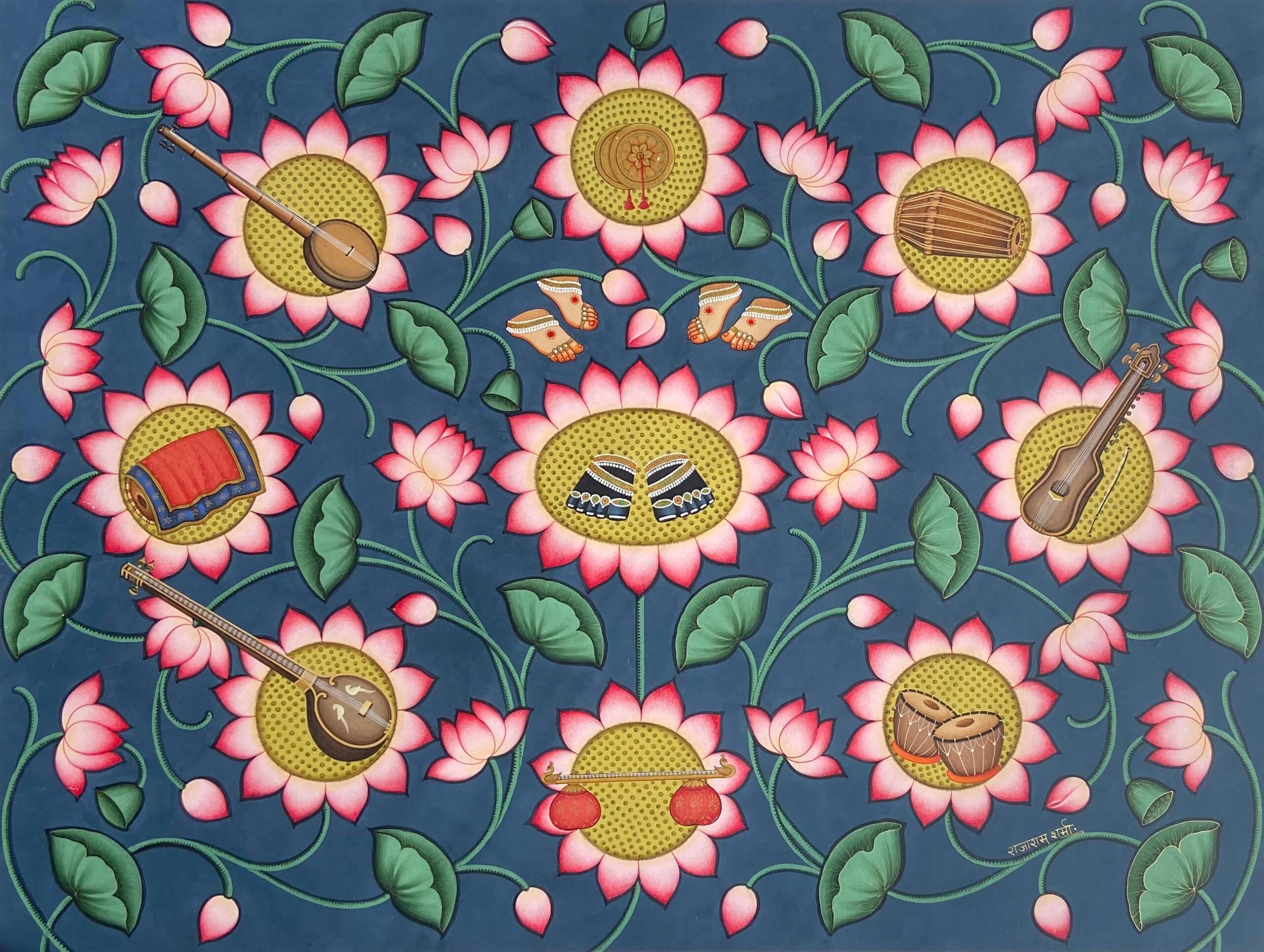RAJARAM SHARMA
DATE OF BIRTH & PLACE:
June, 1963, Bijoliya, Dist.Bhilwara (Raj.)India
QUALIFICATION :
Matriculation.
TRANING/EXPERIENCE :
Start in 1976 in Nathdwara Pichwai Painting in “Guru-Shishya Parampara” under Sh. Tulsidas Chitrakar at Nathdwara. 9Years Experience in Pichwais and Miniature Paintings under President Awarded Artist Lt. B.G. Sharma, in “Guru-Shishya Parmpara” at Udaipur.
AT PRESENT WORKING :
Independently Working on Pichwais, Miniature and other Paintings.
AWARDS :
2004 : All India Award of Traditional Art, Kalidas Academy, Ujjain (M.P.)
2002 : Gold Medal in Traditional Painting at All India Art Exhibition,Jangaon Dist. Warangal (A.P.).
2001 : All India Special Award of Traditional Art, T.A.H.S., Karnataka.
2001 : All India Award of Traditional & Folk Art, SZCC, Nagpur.
1998 : First Prize in District Handicraft Contest, Udaipur (Raj.)
1998 : Specially Honored by Education Minister on 15th August for the Field of Painting.
PARTICIPATED WORKSHOP :
2009 : Vasant rao nayik college of art and social science, Nagpur , (Maharastra)
2009 : Neerja Modi School, Jaipur (Raj.)
2009 : Birla Academy of Art and Culture, Kolkata (W.B.)
2009 : National painters camp by alva’s virasat, Moodabidri, Mangalore(Karnt.)
2007 : “Rupankur Kala Shivir” Kalidas Academy, Ujjain (M.P.).
2007 : Traditional Painting Workshop, Diu by WZCC, Udaipur.
2007 : Miniature Painting Workshop, Kalagram, Chandigar, (Punjab).
2007 : Special Pichwai Painting Workshop, Ahamdabad (Guj).
2005 : “Indradanush” L B S N A A, Mussurie by NZCC, Allah.
2005 : “Varnagam Shivir” Kalidas Academy, Ujjain (M.P.).
2001-2009 : Nathdwara Painting Workshop at Jnana Pravaha, Varanasi (U.P.).
2001 : Multimedia Workshop at Panjei (Goa) by WZCC, Udaipur
2001 : “India Miniature Paintings” at Rajahmundry (A.P.) by SZCC, Nagpur.
1999 : “Traditional Painting Workshop” at Tumkur (K.S.) by
1997 : “Traditional Painting Workshop”at Mathura (U.P.) by NZCC,Allah bad.
GROUP SHOWS :
2009 : Victoria Monroe Fine Art Gallery, Boston (U.S.A.)
2009 : Harmony Art Exhibition, Mumbai (Maharashtra).
2007 : Nthdwara Pichwais Painting Exibition, Ahamdabad (Guj).
2006 : Victoria Monroe Fine Art Gallery, Boston (U.S.A.)
2005 : Kriti Art Gallery, Varanasi (U.P.)
2005 : Chitramai Art Gallery, Hyderabad.
2005 : Kalidas Academy, Ujjain (M.P.).
2001-2007 : “Shilpgram Utsav” in Udaipur by WZCC, Udaipur.
2002 : Sanskar Bharti in Udaipur (Raj.).
2002 : Lalit Kala Academy, Ravinder Bhawan, New Delhi.
2001 : Information Centre, Udaipur (Raj.)
SOLO SHOWS :
2008-2009 : Victoria Monroe Fine Art Gallery, Boston (U.S.A.)
2006 : Chitrashala, Udaipur (Raj.).
2005 : Kriti Art Gallery, Varanasi (U.P.).
2003 : Kala Mela Vankatappa Art Gallery, Bangalore (K.S).
1997 : Urusvati Centre for Art, New Delhi.
WORKS IN COLLECTION:
Shrinathji Temple, Nathdwara. Haveli of Shrinathji, Udaipur,Ghasiyar, NCZCC, Allah bad. SCZCC, Nagpur.Gujarat SidheCement Ltd., Mumbai. Navdeep Pratishthan, Ahamdabad. (Gujarat), Jnana Pravaha, Varanasi (U.P.), Suresh Neotia and Traditional art Trust, New Delhi.Alva’s Virasat, Mangalore (Karnataka), Victoria Monroe Fine Art Gallery, Boston (U.S.A.).
Collection in New Delhi, Mumbai, Bangalore, Kolkata, Vranasi, Surat, Ahamdabad, Varndavan, Jaipur.
Collection in USA, UK, France, Germany, Australia and Pvt. in India and Abroad.
Raja Ram Sharma, born 1963 Rajasthan, had his extensive training in “guru Shishya Parampara” pattern for 12 years in Nathdwara style in Pichwais at Nathdwara and after he polished and gained his expertise in pichwais and miniature paintings for seven years as an apprentice at Udaipur.
He has been specially honoured on 15th August for the Field of Painting and is a recipient of All India Award of Traditional Art SCZCC - Nagpur. Special Award for Traditional Paintings by Tasmiya Art House Society - Gulbarga. Gold Medal, Traditional Paintings at All India Art exhibition, Jangaon Dist. -Warangal (A.P.). All India Award of Traditional Art, Kalidas Academy- Ujjain (M.P.) .His work has been exhibited in a number of important shows
His works can be seen in the collections of Victoria Albert Museum, London - UK. Indology Deptt., Mibblebury University - USA. Shrinath Temple - Nathdwara. Haveli of Srinathji - Udaipur Ghasiyar. Ministry of Handicraft - New Delhi. NZCC Allahabad(U.P.). SZCC Nagpur (M.S.). WZCC Udaipur (Raj.). Victoria Monroe Fine Arts Gallery, Boston. Lekha Poddar- New Delhi and in many important Private Collections.
RAJA RAM SHARMA- WRITE UP
Lining the stairway wall up to a show at Victoria Munroe Fine Art were precise little paintings by an artist named Raja Ram Sharma. Now here was a challenge: How do I look at Ram Sharma's works with a neutral eye, without enjoying them for being "exotic" or trying to bend them to fit into my local mode of understanding? Ram Sharma seems to be hip to the Western handicaps of the audience: Rather than delivering a nice traditional painting of, say, a couple reclining beneath a fig tree, Ram Sharma throws in just enough magic realism to confuse a person. One painting gives an aerial view of a town with neat rows of houses. Near the bottom, a house lies on end, with curly plumes of smoke and sparks rising from it. This could be a convention of perspective, and the plumes could suggest fireworks and celebration-or it could be an American bomb raising hell in a quiet village. The last painting on the wall shows a line of colorfully clad dancing legs, moving to the rhythm of a tambourine and castanets, shaken by anonymous hands poking up from the bottom. It took me a while before I could distance myself enough to enjoy the paintings for their clear colors, lyrical compositions and odd subject matter.
Stylistic localism is not in any way a bad thing, nor does it suggest any naivete on the part of the artist. Any artistic tradition can lay down the path to transcendent expression. The challenge for the audience is to transcend our local eyes, to remove our minds from our perceptions and assumptions about different regional languages of art-to just see the piece for what it is. - Boston's Weekly dig. on Raja Ram Sharma at Victoria Monroe Fine Arts Gallery, Boston
WRITE UP II
One of our most noted traditional painters formally trained in Nathdwara miniature and coming from a long line of traditional painters dedicated to exerting a genuine spiritual influence on society through artistic means, he represents the tradition of paintings associated with the pilgrim city of Nathdwara which is characterised by intricate miniature paint ings and colourful wall hangings known as Pichhvais. He has kept alive the sacred tradition of Indian art through his paintings. The tale of ancient stories transport us to the miraculously divine world, we find a valuable expression of India's spiritual heritage and wisdom as it encounters the contemporary world. The language of symbols he employs inject a significance into the structure of his composition from which the audience can derive deep understanding of his intentions, as in the sacred art tradition of India, styles are many and diverse. The control of artistic symbols and styles conveys the message of literary references, of classical Indian works and scriptures. This refined language of symbols and colours which has evolved into many local and regional styles allows for certain spiritual messages to be understood by the cultured audience . Through precision in detail and formalized expression, a well trained painter, like him, can deliver both the beauty and significance of the vision he has been blessed with.
His works are carried by a sense of devotion grounded in philosophy through the divine play (Lila....) of Krishna and its significance to human society.
He mastered the forms of these traditions at an early age, but it has never been his intention to simply copy these traditions. Instead, his wish is to bring alive the old themes in a more contemporary visual language. His success in doing just that is remarkable. He is reviving a profound beautiful tradition that rs dying, and has emerged as one of the foremost names to reckon with India miniatures.
He has in his works the distillation of the many rich symbols and his reference a canonical language to convey the character of a vision or literary reference. This can be witnessed in the countless stylistic evolutions he has undergone. He says artists practicing sacred art do not labour to seduce the eye; rather, they seek to challenge their creative heart to embrace that initial impression of inspiration.and capture its dignity and its character, for others to experience too.
In his words" I approach my work with a sense of devotion- Bhakti. I study scriptures to understand the nature of the characters I paint and then I use my imagination. I try and draw on existent, though tenuous, traditional techniques and skills and extend them into a contemporary context. I suppose it is essentially about new ways of looking at the familiar."-
Bhupesh Kavadia
